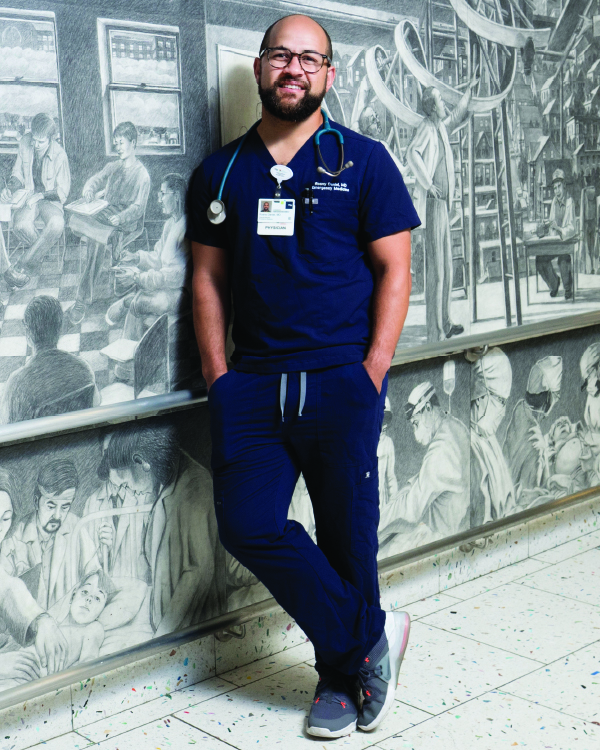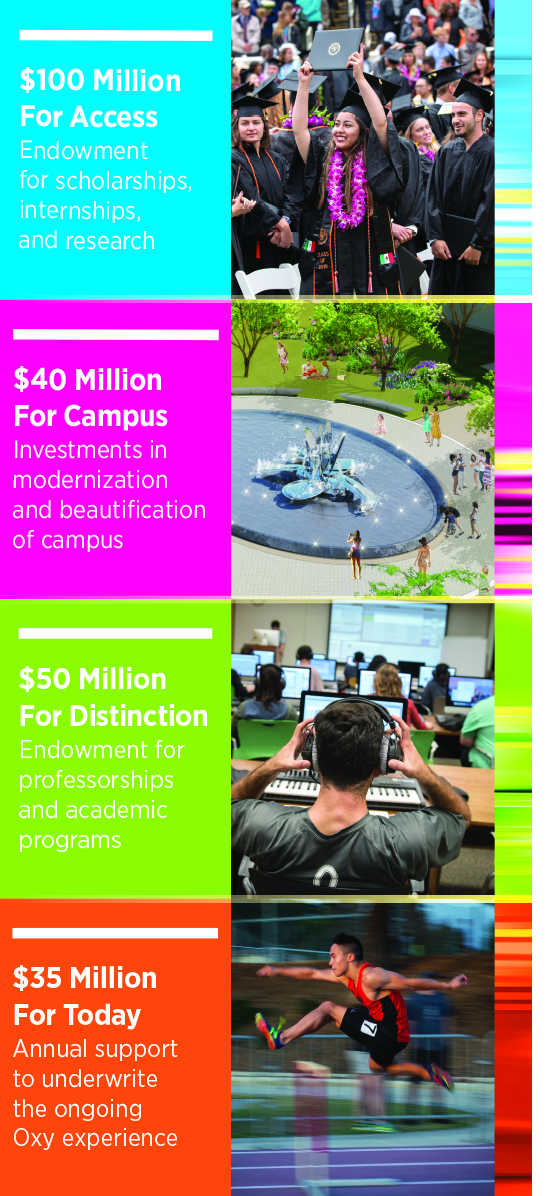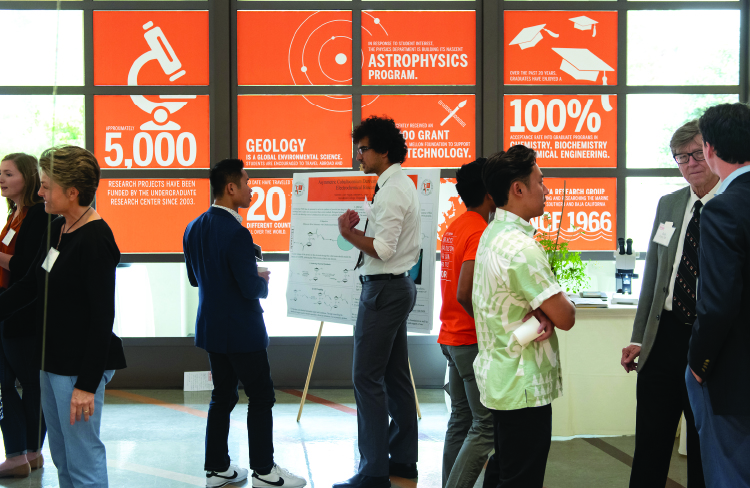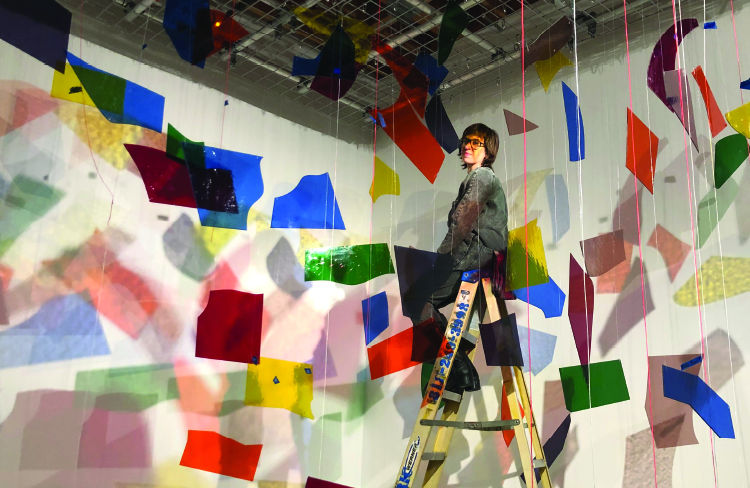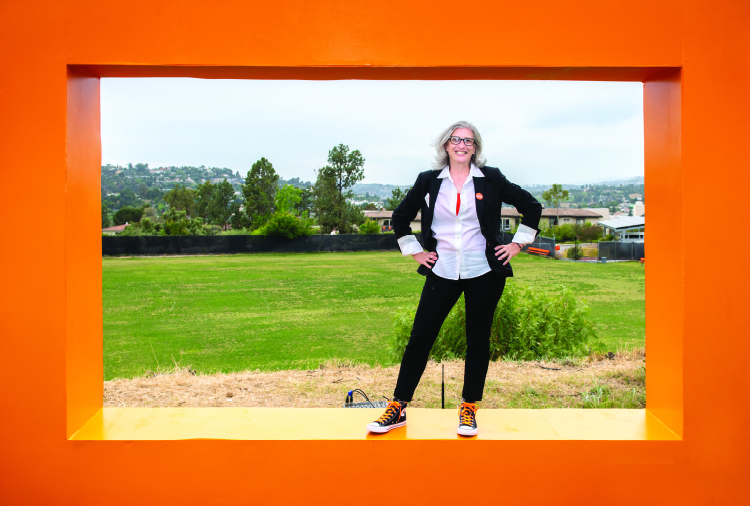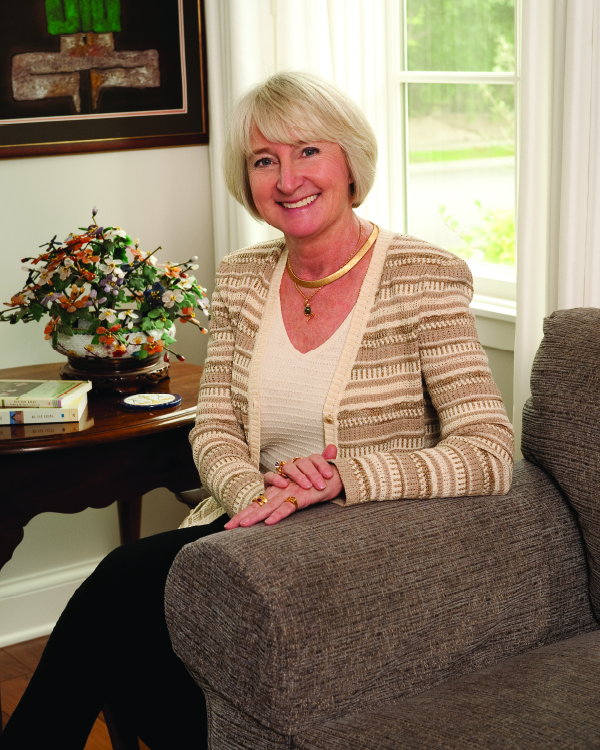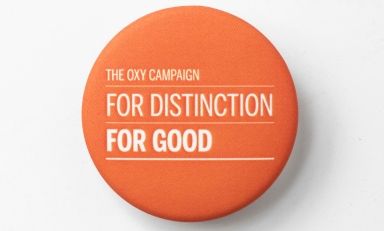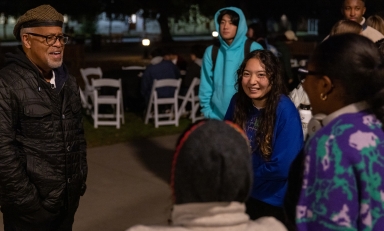With a goal of $225 million, The Oxy Campaign For Good aims to build on the College’s location, curricular strengths, and the power of a liberal arts education. But its success will be measured by both endowment and engagement
“I always tell people that going to Oxy was one of the best decisions I’ve made in my life,” Rosny Daniel ’09 says. “It’s just a unique place—I’m sure everybody says that—but my rugby coach [Malek Moazzam-Doulat ’92] was also my Intro to Islam professor. When I asked him to write me a recommendation for medical school, it was not hard for him to have specific things to say about me.
“I love the smallness of Oxy,” adds Daniel, who majored in biochemistry (with a minor in religious studies) and got his introduction to campus through the Multicultural Summer Institute. “I love the feeling of community within the student body. You’d see people in the Quad, or on the weekend, or at the library. You’d play sports with them and do the cancer walk with them. I can’t even begin to stress the importance of MSI and how it was very formative in my thinking about social and cultural issues. I’ve made a lot of my career out of that.”As a full-time faculty member in the UCSF Department of Emergency Medicine, Daniel splits his time between the classroom and the Zuckerberg San Francisco General Hospital and Trauma Center. In addition to recruiting and mentoring medical school students from all backgrounds, “I’m hoping to continue teaching at the national level and to be involved in changing the conversation around social health,” he says. “This work is important and meaningful, and I just have fun doing it. My goal is always to call people in and not call people out. My Oxy experience set me up to do these things.”
Daniel’s story is one of many—too many to count, really—that embody the boundless potential for good that begins with a liberal arts education. Consider Janette Sadik-Khan ’82, who as transportation commissioner for New York City under Mayor Michael Bloomberg utilized her ability to “translate dreams into action”—a skillset she developed as a political science major. “That’s what I learned at Occidental and that’s what I was so proud to deliver on the streets of New York City.”
Or Joe Rohde ’77, the veteran Disney Imagineer who considers his chief successes (including Disney’s Animal Kingdom in Florida and Aulani hotel in Hawai‘i) a byproduct of his liberal arts education. “I came to this job with no other aptitudes,” says Rohde, who majored in art at Oxy. “I am not the best model builder, illustrator, or set designer. I have this other aptitude, which is this critical thinking, the ability to investigate and negotiate. That strength comes from Oxy.”
Or Andrew Heath ’04, chief financial officer and chief operating officer of Bombas, which donates to a homeless shelter one pair of socks for every pair it sells—totaling nearly 20 million pairs to date. Whether it was cleaning up the L.A. River, tutoring underprivileged students, or getting out the vote, “It seemed as though almost everyone at Oxy had some philanthropic thing that they were doing,” says Heath, who majored in economics. “There are many other alumni from my class and others who do a lot of good.”
“I have always believed in the power of a liberal arts education to change lives, and that’s what Oxy does better than anyone,” says President Jonathan Veitch. The unifying idea of the College’s four cornerstones—excellence, equity, community, and service—is the desire to make the world a better place and equip Oxy graduates for their vital role as citizens of a democracy.
That idea is the foundation of The Oxy Campaign For Good, the most ambitious fundraising initiative in College history and Oxy’s first comprehensive campaign in nearly a quarter-century. With a $225 million goal, the endowment-driven campaign “aims to bring our community together to invest in Occidental’s future and expand our ability to do what we do best—identifying and educating talent wherever we find it,” Veitch says.
Since the quiet phase of the campaign began in July 2016, Occidental has raised more than $123 million in commitments, including $55 million in planned gifts. Its overall priorities fall into four categories:
For Access: $100 million. More than seven out of 10 Oxy students receive some form of financial aid, which totaled a record $49.4 million in the 2018-19 fiscal year. Growing the endowment for financial aid—the campaign’s top priority—will give Occidental the flexibility to continue to provide gifted and diverse students access to an Oxy liberal arts education regardless of their circumstances.For Campus: $40 million. The Beaux Arts charm of the Occidental campus reflects the vision of Myron Hunt, the Pasadena architect who created its original master plan and designed every building erected on campus for 30 years. The average age of Oxy’s 80 buildings is 63 years old—and a long-standing commitment to asset renewal will ensure that the College’s most cherished structures are preserved and reimagined to meet the demands of an evolving curriculum.
For Distinction: $50 million. New endowed professorships will make it possible for Oxy to attract top talent and reward outstanding faculty. The College also has plans to expand the footprint of its media arts and culture and music majors—building on Los Angeles’ role as a global creative epicenter.
For Today: $35 million. Unrestricted giving underwrites every aspect of the Oxy experience for current students and provides budget relief for the College’s daily operations. Oxy Fund dollars support scholarships, growing technology demands, faculty and student research, and extracurricular experiences—from internships and athletics to community engagement and Dance Production.
The campaign’s priorities were formulated after lengthy consultations with alumni, faculty, students, parents, and staff, including the 21 alumni and parents who served on the College’s Student Access and Opportunity Task Force, co-chaired by trustees Rick Rugani ’75 and Eileen Brown ’73.
Financial aid made it possible for Rugani and his siblings—older brother Frank ’70 and younger sister Maria ’78—to get an Oxy education. “There’s no way our family would have been able to finance all the kids going to college,” he says. For Brown, a first-generation college student whose father died unexpectedly at the start of her sophomore year, financial aid made all the difference. “I still remember that tuition was $2,400 a year, because I had to pay for it,” she says.
“Without having a strong endowment here at Oxy, we can’t attract professors, we can’t attract students for the long term, we can’t pay for financial aid, and we can’t pay for the campus itself,” adds trustee and task force member Bonnie Mills ’81, who spoke at the kickoff for the public phase of the campaign May 18—the culminating event of a daylong Campaign Leadership Summit on the Oxy campus. “College is so expensive now that all of us need to support the next generation in whatever way we can.”
Rebecca Kemp ’04 was just beginning her sophomore year when the Twin Towers fell on Sept. 11, 2001. “Because she had grown up in suburban New York, I think it hit closer to home than it would have if she’d grown up in Missouri,” recalls her father, Gil Kemp, an Oxy trustee since 2015. “She ended up coming home and took the semester off, and Oxy was very supportive in that process.” Rebecca returned to Oxy the following semester and graduated with a B.A. in history. Now a full-time mother of four, she lives in Johannesburg, South Africa, and does volunteer work for orphans, “of which there are sadly a great many,” Kemp says.
“It’s a tribute to Oxy as an institution that they care deeply about each individual student,” adds Kemp, who is co-chairing the campaign with financial adviser and trustee Anne Wilson Cannon ’74, real estate investor and adviser William M. Kahane ’70, and trustee emeritus Ian McKinnon ’89, founding partner of Sandia Holdings.
A longtime proponent of the liberal arts, Kemp graduated from Swarthmore College in 1972 and founded Home Decorators Collection in 1990, growing it into one of the nation’s leading direct sellers of home furnishings and accessories. He retired as president in 2009, some three years after its acquisition by Home Depot.
Kemp has endowed a number of “modest scholarships” at Occidental since Rebecca’s graduation. “It’s a very fulfilling way to support an institution and have a sense of connection with students,” he explains. “It’s always a pleasure to meet them and see how terrific they are.”
While endowed scholarships such as Kemp’s currently make up almost half of Oxy’s endowment, generating more than $9 million annually, that accounts for less than 19 percent of the overall financial aid budget. The rest comes directly from the College’s operating budget.
“Occidental is able to attract bright students from all walks of life, including those students who might not be able to pay the freight,” says Kahane, who with wife Elizabeth endowed the College’s United Nations program in 2014. “They need some form of subsidy, and that’s what an endowed scholarship program provides.”
As part of the campaign’s $100 million For Access initiative, the College launched the Barack Obama Scholars Program last fall, raising more than $12 million to date in the interest of empowering the next generation of leaders to actively pursue the public good. The College will welcome its third and fourth Obama Scholars with the incoming Class of 2023.
“The Obama Scholars Program is an incredible opportunity for people from all kinds of backgrounds to enjoy an Oxy education without having to worry about financial aid or affordability, and to actually have people who are deeply committed to making change in the world today, to leaving the world in a better place than they found it,” says Sadik-Khan. “It’s really inspiring to see the passion, energy, and integrity they bring to the table and so I’m even more excited to see where they go from here.”
After Associate Professor of Music David Kasunic was named department chair in July 2014, he says, “There was a collective will among the faculty to have the curriculum look more like what students may want to take and connect more to the industry”—to offer coursework in such areas as music production, music business, and songwriting “in the context of a liberal arts education as a critical argument-based enterprise.”
To that end, the Dean of the College’s Office approved the creation of a full-time teaching position in music production. And musician and philosophy major Ramona Gonzalez ’09, who performs under the name Nite Jewel, will be returning next spring as the Johnston-Fix Professor of the Practice in Songwriting. (She won raves from students last semester, according to Kasunic: “Ramona is rigorous, smart, creative, stimulating, and completely engaging.”)
Additional funding from the Mellon Foundation has brought to campus top industry professionals such as Ludwig Göransson, who won both an Oscar and a Grammy for his Black Panther score and produced Childish Gambino’s Grammy-winning “This Is America.” “These are the kinds of opportunities you get by virtue of being in Los Angeles,” Kasunic says.
In recent years the music program has seen an uptick in majors, with 32 students currently enrolled (including 11 members of the Class of 2020—more than double the number of graduates in 2019). Over the summer, the department’s music library was moved to the Academic Commons to make room for a new music production space designed by architect Peter Grueneisen, whose firm has designed soundstages for Sony and DreamWorks Animation as well as for Academy Award-winning composer Hans Zimmer (The Lion King).
On the drawing boards is a new or revamped building that would bring the music and media arts and culture (MAC) programs adjacent to Booth Hall. “We are trying to deliver a 21st-century curriculum in mid-20th-century facilities,” Kasunic says. “We believe this will be a game changer—not just for the departments but for the entire College.”
“In a city that’s full of trade schools and large university programs that are geared to placing people directly into an industry, I think the liberal arts context steps out and stands out because of the social questions that our students are asking,” says Broderick Fox, professor and chair of the Media Arts & Culture Department.
“Not only are we professionalizing students technically but we’re giving them the critical skepticism, the local/global perspectives, the interdisciplinary opportunities, and a set of driving questions with which they can approach these increasingly complex and daunting—but also exciting—possibilities of this moment we’re in,” Fox adds.
While Oxy has neither the resources nor the aspirations to develop a film school in the vein of USC or UCLA, “We’re uniquely positioned to cultivate creativity,” says Charlie Cardillo, vice president of institutional advancement. “A media arts and culture program anchored in the liberal arts can be unlike any other program anywhere else.”
On the opposite side of campus, the most pressing construction need is Norris Hall of Chemistry. Built in 1960 and partially renovated in 1990, it’s a prime candidate for renovation to meet the needs of an ambitious, hands-on teaching and research program.
A member of the Occidental faculty since 1982, Chemistry Professor Chris Craney was involved in the last renovation of the building, concurrent with the construction of the Bioscience Building. “While we substantially advanced the conditions for our chemistry instruction by building really wonderful organic chemistry labs, we focused on the highest-need areas and didn’t do much in terms of the general chemistry labs,” he says. “It was clearly intended to be a stop-gap measure.”
Nearly 30 years later, many students arrive at Oxy having studied high school chemistry in facilities far more advanced than the College’s. And while Craney acknowledges that fact, the more vital case for investing in the chemistry building is that roughly one-quarter of all students take a chemistry class during their four years at Oxy. “All those kids are doing labs, and right now they’re all squeezed into a really small, constrained space, which is frankly inadequate,” he says. “We need more space for our instructional labs, for student research opportunities, and for instrumentation and equipment.”
Issues such as climate change, energy consumption, food production, and human disease pose “really major important questions,” Craney continues, “and chemistry and biochemistry are going to play an important role in preparing students to address those questions—not just address them by recognizing them but actually make positive contributions toward solving some of these challenges. But we can only do that if we have the facilities that allow us to carry out our teaching and research but also prepare the students to understand these problems in more than a superficial level.
“Oxy has traditionally punched way above its weight class in the sciences,” Craney says. “We have an investment in the faculty members who are here that can only be unlocked if we provide the resources, facilities, and opportunities for them to share their knowledge and enthusiasm with the next generation.”
A multiyear renovation of Norris Chemistry is high on the list of Oxy’s construction priorities, according to Tom Polansky, the College’s associate vice president of facilities management. He and his team have begun planning meetings with two architectural firms and chemistry faculty to address laboratory space and other technical concerns. “The actual timeline for construction will depend on funding,” he adds—which highlights the challenges of keeping up with deferred maintenance with limited resources.
In January 2018, an outside engineering firm did a top-to-bottom inspection of the campus and created a database of over 3,000 individual building elements—every pump, motor, boiler, roof, window, and door lock—to determine the estimated useful life of each component. Oxy’s facilities team spent months going through the list line by line, sorting and prioritizing projects into multiple categories by greatest need.
“What we need is significant funding to make a dent in this list,” Polansky says, noting that Occidental addressed $2 million in asset renewal needs last year. “When you think about the small liberal arts college experience, we have to leverage our advantages, and one of our best advantages is our iconic campus.”
Oxy’s chief calling card aesthetically is its collection of 19 Myron Hunt-designed buildings—the most in any one location by the famed Beaux Arts architect. “It’s a distinct competitive advantage to have those buildings, as they impact the learning experience in so many ways. In addition, the outdoor spaces they frame create opportunities for interactions that affect the quality of living and learning on campus,” Polansky says.
In harmony with Hunt’s legacy, the College engaged Pasadena architect and urban planner Stefanos Polyzoides, who curated a 1984 exhibition of Hunt’s work, to design the De Mandel Aquatics Center, which will be dedicated October 18 during Homecoming & Family Weekend. The state-of-the-art pool “embodies the spirit of Myron Hunt—it looks distinctly Occidental,” Polansky says. “We’re creating places for experiences that students will remember for a lifetime.”
The De Mandel Aquatics Center and expanded McKinnon Family Tennis Center are among the most visible outcomes of The Oxy Campaign For Good. The new facilities are just a javelin’s throw away from the Payton Jordan Athletic Center, which was refurbished and reopened this spring through the vision and generosity of Linda and Tod White ’59, whose matching gift challenge helped pay for the project.
The Whites’ philanthropy didn’t stop there, however. Their support also helped secure a new home for Oxy Arts, the College’s multidisciplinary arts programming initiative—one that deepens the College’s relationship with Northeast Los Angeles.
In January 2018, Meldia Yesayan took the job as director of Oxy Arts “because I wanted to be part of a larger institution that believed in the power of the arts and culture to bring people together and invested in that as a core part of their mission,” she says. At the time Oxy Arts was housed in Booth Hall, in a 5-by-8-foot space that had been the harp closet.Since its creation in 2014, Oxy Arts had functioned as an itinerant initiative. “We programmed wherever we could find space,” Yesayan says, “sometimes in the community but often around campus.” That’s all changed with the May 22 opening of the Oxy Arts building at 4757 York Boulevard, in a building purchased by the College in 2015.
For its opening exhibit, NELA Stories, “We offered a historical and collaborative program that incorporated 32 voices and a local artist with various departments on campus and 31 Oxy students,” Yesayan says. The reception among community members has been overwhelmingly positive: “What we’ve heard is, ‘I see myself and I see my story in this space and I feel welcome here.’ ”
Another project nearing completion is the Anderson Center for Environmental Sciences, whose DNA can be traced back to the arrival of John McCormack, associate professor of biology, as curator of the Moore Lab of Zoology. “The first draft of the design for the new Moore Lab was me sitting down with PowerPoint, maybe a year after I got here, sketching out what I thought would be a better way to plan the space,” says McCormack, whose current research project (funded by a five-year National Science Foundation grant of $787,000) examines how human-caused habitat change has affected birds across North America.
The arrival of the Cosman Shell Collection in 2015, coupled with the existing bird and fish collections, “made it clear that what we were doing with our biological collections and using them to answer interesting questions and involving students in them was bigger than just one professor’s lab,” he adds.
If Oxy is to build environmental sciences into a signature program of the College—“which is the hope,” McCormack says—a new building is just the foundation. “I think the door is open for something that’s like the McKinnon Center for Global Affairs. Not only did they get a beautiful new space but they got an endowment to fund things like research and a speaker series and a chair. Those are the pieces we currently don’t have.”
What will Occidental look like academically after the campaign? Since her arrival as vice president for academic affairs and dean of the College in July 2017, Wendy Sternberg has been working with Oxy faculty on updating the academic components of the College’s strategic plan. “We’re not proposing any radical changes to the curriculum, but we want each of our programs to think about how they can best realize the goals that we have stated are our priorities for the academic program: close one-on-one work between students and faculty, incorporation of more research into the curriculum, and connection with the community outside the campus,” she says. “You can see those things taking shape across the liberal arts discipline.”
From critical theory and social justice to diplomacy and world affairs to urban and environmental policy, “Our faculty have really done an outstanding job over the years in crafting a curriculum that makes sense for who we are as an institution,” Sternberg says. “Oxy really gives our students an opportunity for focused study in disciplines that are grounded in the liberal arts, but that have a particular focus and flavor to them that you don’t get at other institutions. The campaign will have a direct impact on how these programs thrive.”The durability of the liberal arts model is matched by the flexibility among traditional disciplines to adapt to the changing needs of not only the workplace but the student body.
Economics—the College’s most popular major for more than two decades—is well-positioned to weather generational change in its professorial ranks, but endowing additional positions will enable the College to recruit and retain the next wave of dynamic faculty and reaffirm the department’s outstanding reputation.
“Ultimately, we’re a liberal arts institution,” Sternberg adds. “We’re not going to become a media school or music production institute. We will always teach the broad range of the academic disciplines—the languages, the humanities, the social and natural sciences. But if we are not evolving our curriculum we’re not providing the kinds of experiences our students are expecting.”
The Oxy Campaign For Good, she says, is “really about advancing those kinds of curricular initiatives that have a special place here at Oxy, as well as some new academic programs that have arisen from these interdisciplinary spaces. One is Black studies, which we are committed to supporting. Our computer science program has just taken off, and our media arts and culture program has exponentially grown. And the new music production path in the music major is both about creative inquiry in the arts and about students creating. That’s part of the one-on-one work—the original productions that students do across the disciplines as well as various kinds of research and creative and scholarly endeavors.”
“The liberal arts model has absolutely thrived in the United States—nobody else does this, and Oxy is the embodiment of that ideal,” says trustee Chip Blacker ’72, professor emeritus of the Freeman Spogli Institute for International Studies at Stanford University and co-chair (with Sternberg) of the presidential search committee to find Veitch’s successor. “And it means learning critically, up close and personal, with people who are devoted to teaching and mentoring. But I don’t think even people who are generally pretty thoughtful about their college experience understand how precious—and how vulnerable—this model is.
“Higher education in America is expensive,” he continues, “and there are ways that those costs are made manageable by families that otherwise would not have the means to attend a place like Oxy.” Most of these institutions survive through a combination of dedication on the part of faculty and administrators “who understand the preciousness of this educational experiment,” and the willingness of alumni “to turn our attention back toward those institutions … and to do what we can to ensure their futures.”
From undergraduate research and study abroad to the Kahane U.N. Program in New York City and Campaign Semester, “The opportunities at Oxy cannot be matched at a larger institution,” says campaign co-chair Anne Wilson Cannon ’74. “A lot of what we do here requires some extra funds. Putting on an education like this is very expensive and not everybody can afford the full freight.”
By her reckoning, Cannon has given to Occidental every year since 1976, when she graduated from the Wharton School at the University of Pennsylvania. “At first it was a sense that I should give back. My parents explained to me that although they were paying the full room and board for me to attend Oxy, that was not the full cost. That’s because other people who had preceded me had given to the College through the endowment and their annual gifts—and that helped fill the gap between what parents were being asked to pay and the full cost of my education.”It was with a feeling of duty, then, that she initially gave to Occidental—“to make up for a gift had been given to me. But as the years progressed, I found myself approaching my annual gifts as, ‘I’m paying it forward. I’m helping current students get the education I’d been blessed with.’
“Oxy has been in my estate plans for many years and I never told the College about it because there was no reason to tell them —it was just my thing,” she explains. Cannon revealed her gift as a show of support for the campaign: “I’m one of Oxy’s biggest fans,” she admits, “and you feel good about giving when it’s going for a good cause.”
“Once the campaign was announced, I felt that it was important to be part of it,” says trustee Gloria Duffy ’75, president and CEO of the San Francisco-based Commonwealth Club, the largest and oldest public affairs forum in the United States. “I’ll try to do as much as I can while I’m alive, but I have made a $5 million legacy gift to Occidental, and I’ll do whatever I can to add to that.”
In addition to laying the foundation for her life’s work, she says, “Oxy invigorated me intellectually and gave me even more of a sense of social mission than I had when I came. It’s extremely important to nurture that.” Working with Brice Harris, professor of history, she developed an independent course of study to look at the potential for transition to majority rule in Zimbabwe (then known as Rhodesia).
“That was the type of support I received at Oxy,” Duffy adds. “It’s a place where young people can become aware of the needs in society and gain the knowledge and analytical capability to contribute in a positive way. It’s important for me that my legacy gift go to the endowment because I want Occidental to have the income and resources of an endowment large enough to fund its needs.”
While planned gifts such as Cannon’s and Duffy’s will pay enormous dividends to Occidental in the long run, the annual support of thousands of alumni through the Oxy Fund is essential to sustain the momentum the College has enjoyed under Veitch. In fiscal year 2018-19, Oxy raised $4.7 million in current unrestricted gifts, even as overall alumni participation continues to be an area for much-needed improvement.
Perhaps some alumni will follow the example of Jill Normington ’94, who observed her milestone 25th reunion by making her first trip to campus in more than 20 years and by increasing her Oxy Fund gift to $2,500—$100 for each year since graduation.
When she got her initial financial aid offer from Oxy, “It wasn’t great,” Normington recalls. But when Youlanda Copeland Morgan, the College’s director of financial aid, learned of her situation, she spent hours with Normington on the phone, rerunning the numbers and sending her a revised financial aid package “that was tons better,” Normington says—and that made all the difference in being able to afford Oxy. “I can’t say enough good things about how amazing the staff was. Every person I worked with in the Business Office could not have been nicer to me over the four years I was at Oxy.”
A principal at Normington, Petts & Associates—the political consulting firm at which she became a partner in 2007—Normington majored in psychology at Oxy and uses those lessons as a pollster “every single day,” she says. “Professor Elmer Griffin taught us how to use clinical psychology in a very directed applied setting. We published papers. We presented research at conferences. My Oxy experience was foundational in developing me into the person that I am.”
Which brings us all the way back to Rosny Daniel, who worked as a TeleFund caller on campus and still knows the drill a full decade after graduation. “I was very good at getting hung up on 30 times but getting one person to talk to me, so I know the feeling,” he says. “My favorite thing to do when I’m talking to TeleFund callers is to ask them the standard questions that they are taught how to answer in their training.” Then he tells them that he’s joking and that he’s going to make a gift.
“Oxy gave me so many different opportunities,” Daniel adds. “I always try to give back.” And that’s a good place to end.


